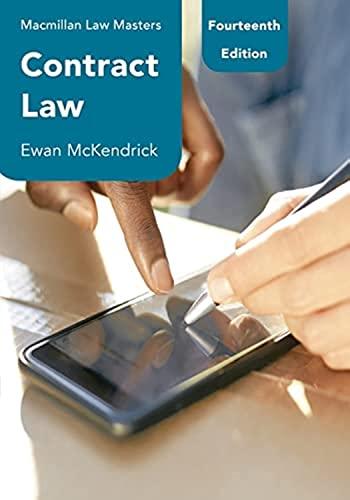Question
For the following problems (questions 11-12), provide an answer in three parts. For part (1), state the estates created by the conveyance before the application
For the following problems (questions 11-12), provide an answer in three parts. For part (1), state the estates created by the conveyance before the application of the common law Rule Against Perpetuities; for part (2), state the estates created after the application of the rule if it is applicable; and for part (3), provide an explanation of your answer. Explain your answers fully, including the how and why of the rule application.
For part (3) of each question's answer, you do not need to put your answer in a [CREAC/IRAC] format. If there is no change because neither the Rule Against Perpetuities nor any other rule we've studied apply to any interest, then that's all you have to state. If there's no change because the Rule Against Perpetuities applies to one or more interests but the interest or interests do not violate the Rule, then you do need to explain why each interest to which the Rule applies does not violate the Rule. This might only be a sentence or two, but it does need to be specific to the conveyance. If there is a change between (1) and (2), then you need to explain why the Rules Against Perpetuities invalidates one or more interests or why whatever rule does apply changes the interests created. For the Rule Against Perpetuities, you would need to explain the scenario that shows the interest violates the Rule. That does not mean you need to write out all the steps you use to create that scenario. You just need to describe the scenario and explain how it shows the interest violates the Rule Against Perpetuities.
For these questions (questions 11-12), assume that the jurisdiction in question follows the common law Rule Against Perpetuities, the Rule in Shelley's Case, the Doctrine of Worthier Title, and the Doctrine of Destructibility.
11. "O to A for life, then A's oldest surviving child for life, then to A's grandchildren." At the time of the conveyance, A has been predeceased by his wife and has 3 children and 2 grandchildren.
12. "O to A for life, then to first grandchild of A to graduate from law school." At the time of the conveyance, A is married and has 2 children but no grandchildren.
Step by Step Solution
There are 3 Steps involved in it
Step: 1

Get Instant Access to Expert-Tailored Solutions
See step-by-step solutions with expert insights and AI powered tools for academic success
Step: 2

Step: 3

Ace Your Homework with AI
Get the answers you need in no time with our AI-driven, step-by-step assistance
Get Started


